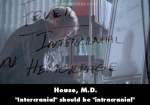Factual error: Chase and Foreman suggest the evidence of the pharmacy log is inadmissible at court due to patient-doctor confidentiality, but Cameron states House was neither the patient nor the doctor in question, and so confidentiality does not apply. Cameron's point is irrelevant: since the patient (who has died) and doctor in question (Wilson) did not consent to Tritter's reading the log, confidentiality still applies. As such, Tritter did not validly acquire this evidence, and it is indeed inadmissible. (00:04:18)
Factual error: The boy plays a game of chess at a tournament against some other person. The camera only shows a few pictures of the board, however, when the boy says "goodbye" and the game ends, due to an allegedly checkmate, the following is shown: the opponents king is on f7, with his own figures all around but e8 and h7-9 being free. On h5 is the boy's rook which attacks the h7, h8 and h9 fields. Now the boy moves his bishop to h6, thus attacks f7 (where the king is) and e8 (the only free spot but h6-8). Now of course h6, f7 and e8 are not available to the king anymore, but as the bishop blocks the rooks attack on the h-line, the king now has the fields h7 and h8 to go to. Thus it's by no means "checkmate." (00:01:00)
You Don't Want to Know - S4-E8
Factual error: Amber triggers a fire alarm by heating the sprinkler with her lighter. Unfortunately that fire sprinkler doesn't detect heat (or smoke). The sensor is located between the ceiling lamps, about two meters from the fire sprinkler. (00:09:00)
Suggested correction: Heat applied to the sprinkler would cause it to activate and spray water. All modern fire systems will detect this water pressure drop and activate the alarm.
You Don't Want to Know - S4-E8
Factual error: Dr. House argues that the symptoms of the patient (DIC, bleeding, and multisystem failure) can be explained by the fact that they gave him the wrong type of blood (type AB). House says the reason they could make such a mistake is that they don't test blood type, they test antibodies. Dr. Foreman responds it's because the human body only makes those antibodies when you have that type of blood. This part is incorrect. In fact, it's the exact opposite. You only produce antibodies against the antigens that you DO not have. If you did, your immune system would attack your own red blood cells (RBCs), which would cause autoimmune hemolytic anemia (aiha). For example, if your blood type is A, you make antibody B and vice versa. A person with blood type AB has A and B antigens on the RBCs, but does not produce antibodies A or B and is therefore a universal recipient. Ironically, the latter is also mentioned by Dr. Wilson in a conversation with House earlier in the episode when he says "Of course you're type AB - universal recipient. You take from everybody." House then says that the patient has blood type A, but he's making an extra antibody of type B, which led them to believe he has blood type AB and therefore give him type AB blood. House then deduces that this caused the immunologic reaction, leading to the diagnosis, SLE (lupus), which can cause acquired aiha. It's correct that giving type AB blood to a person with blood type A would cause this, but the first part is wrong. If he is type A, he is supposed to make antibody B, not antibody A, so if he were making an extra antibody, it would be antibody A, not antibody B. (00:38:20)
Factual error: House diagnoses contagious ecthyma in a patient exposed to a donkey. This zoonosis is however NOT transmitted by donkeys. "Contagious ecthyma virus causes papillomatous lesions on lips and mouth, and sometimes on the interdigital areas of primarily young sheep and goats. The hosts of contagious ecthyma virus are sheep, goats, alpacas, chamois, Rocky Mountain Bighorn sheep, Doll sheep, steenbok, wild thar, dog, camel, reindeer, musk ox, and man." https://doi.org/10.1016/B978-0-12-524180-9.50039-X. (00:27:07 - 00:27:40)
Factual error: In episode 414, "Living the Dream," the patient Evan is given a nerve function test. We see Kutner and Taub performing the test by puncturing Evan's legs with needles. Modern nerve function tests actually rely on electrical impulses from a small computerized device, with no needles necessary.
Suggested correction: House ordered an EMG (electromyography) to test for motor nerve entrapment. During an EMG, one or more small needles (electrodes) are inserted through the skin into the muscle. The electrical activity picked up by the electrodes is then displayed on an oscilloscope. An audio amplifier is used so the activity can be heard. When an electrode is inserted, a brief period of activity can be seen on the oscilloscope, but after that, no signal should be present.
Factual error: When Dr. Cameron's agoraphobic patient goes into cardiac arrest at home following the surgery, she tells House to get the paddles ready. House, while performing CPR is talking on the phone with the patient's lawyer, informing him that patient has PEA (pulseless electrical activity) on the cardiac monitor, but Dr. Cameron defibrillates the patient anyway, restoring the heartbeat. Defibrillation is not indicated for PEA, it will not restore the pulse and might send the patient into vFib.
Factual error: During the differential, Chase suggests the underlying condition is a systemic infection. House says this is unlikely since the patient received IV antibiotics the previous week. However, the doctor in the intro scene remarks that he thought the patient had C. Diff, which is treated with oral vancomycin, not IV. Oral vancomycin has next to no oral absorption, and would not treat a systemic infection. Moreover, even if vancomycin was orally absorbed, it would only treat infections caused by gram positive organisms and not other infections caused by gram negative organisms. (00:12:30)
Factual error: When Dr. House is in the treatment room with a patient that has a gunshot wound to his foot, he removes a bloody dressing and treats the area without wearing gloves. No health professional would do this.






